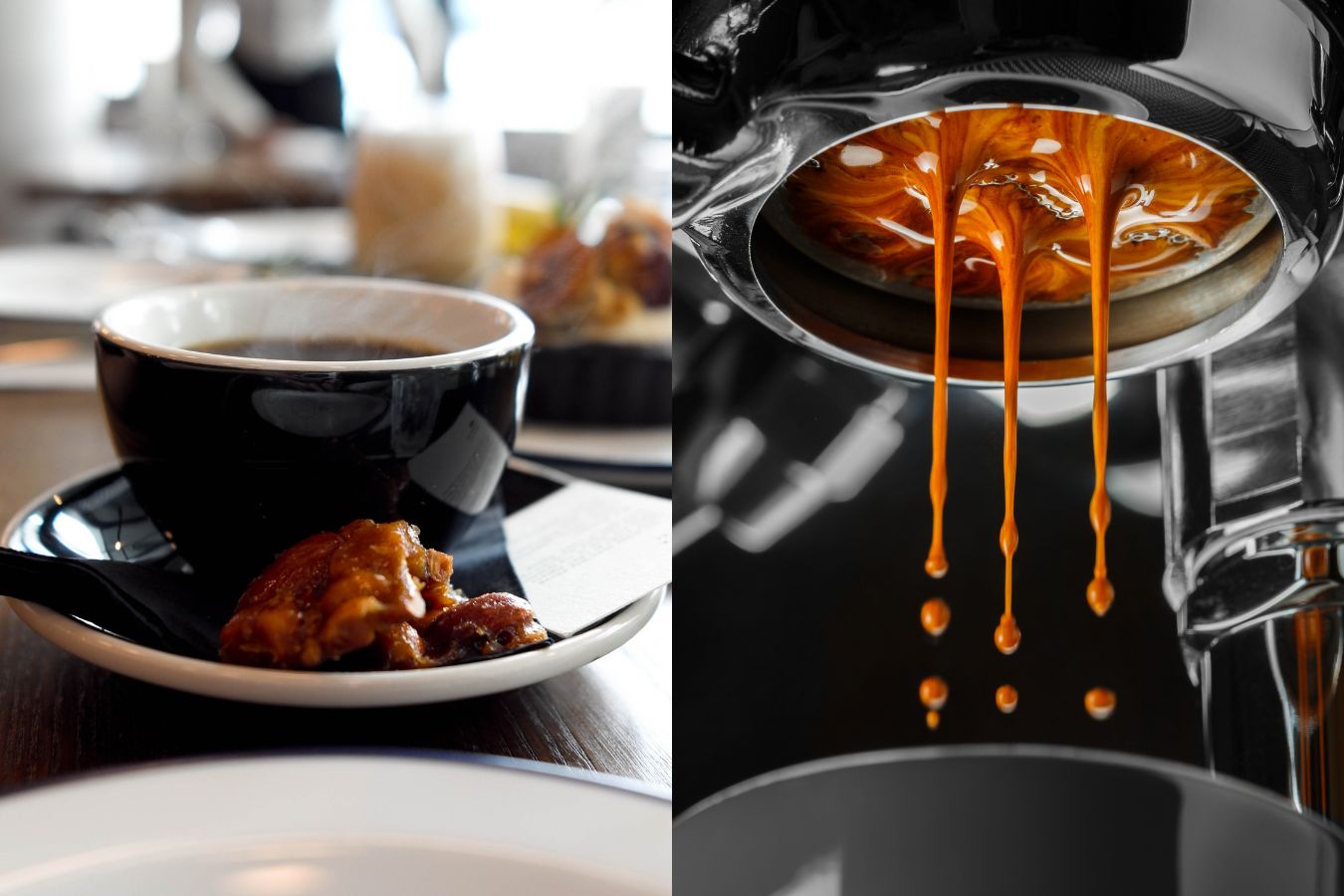Experience the Rich Flavor Profile of SOE Single Origin Espresso Today
Wiki Article
Coffee Beans Uncovered: Uncovering the Keys of Espresso and Blended Coffee Beans
When you think of coffee, what comes to mind? Is it the rich scent of espresso or the complexity of a well-crafted blend? Comprehending the nuances of coffee beans can transform your experience. Each selection, from Arabica to Robusta, holds its very own secrets. As you explore additionally, you'll reveal just how these beans form flavors and impact sustainability. What might you find about your following cup?The Origins of Espresso: A Historic Viewpoint
Although espresso is now a staple in coffee society worldwide, its beginnings map back to the early 20th century in Italy. You may be amazed to discover that the development of espresso was driven by a wish for rate and performance. In 1901, Luigi Bezzera patented the initial coffee maker, intending to brew coffee faster than standard methods. This development quickly caught the focus of Italian coffee drinkers, resulting in the coffee bars we are acquainted with today.Recognizing Espresso Beans: Characteristics and selections
When you think concerning coffee, it's necessary to acknowledge the different bean varieties and their distinct tastes. Each type brings a distinct personality to your cup, influenced by factors like roast levels. Understanding these components can raise your espresso experience substantially.Espresso Bean Varieties
As you explore the globe of coffee, you'll promptly uncover that not all beans are created equal; each variety brings its very own one-of-a-kind tastes and characteristics to your mug. The most prominent types include Arabica and Robusta. Arabica beans are recognized for their smooth, nuanced flavors and reduced high levels of caffeine material, making them a preferred amongst coffee lovers. On the various other hand, Robusta beans pack a more powerful strike with higher high levels of caffeine and an extra bitter taste, often preferred in blends for their crema-enhancing top qualities. You might likewise experience specialized beans like Liberica and Excelsa, which supply unique profiles and are much less typical. Each variety offers something various, so exploring will assist you find your perfect coffee.Taste Profiles Discussed
Understanding the taste profiles of various espresso beans can boost your coffee experience. Each bean selection provides distinct characteristics that affect mouthfeel, fragrance, and taste. For example, Arabica beans frequently provide a sweeter, a lot more intricate taste with tips of fruit and flower notes, while Robusta beans tend to be bolder, with nutty and earthy undertones.When you discover single-origin beans, you may uncover distinctive regional flavors-- Main American beans may be bright and citrusy, whereas Italian blends usually provide abundant, chocolatey notes.
Roast Levels Influence
Roast levels play an important duty in shaping the taste and fragrance of coffee beans, affecting your general coffee experience. Recognizing these roast levels aids you pick the espresso that suits your taste preferences. Exploring with various roasts can lead to fascinating discoveries, boosting your appreciation for espresso.The Art of Blending: What Makes Blended Coffee Unique
What makes blended coffee so fascinating? It's all concerning the art of integrating beans from various origins, roast levels, and flavor accounts. When you blend, you're not simply blending; you're developing an unified equilibrium that highlights the strengths of each bean. You can experiment with various mixes to boost sweetness, body, and acidity, causing a mixture that's richer and more complex than a single-origin coffee.Mixing additionally enables you to provide to varied taste preferences. You can craft a blend that's smooth and mellow or one that's vibrant and durable, relying on your target market. Plus, blending can assist keep consistency, offering a trusted flavor experience no matter of seasonal variants in beans. So, whether you're a home or a barista maker, mastering the art of blending opens a globe of creative thinking and flavor possibilities, making your coffee experience absolutely one-of-a-kind - SOE.
Flavor Accounts: Sampling Notes of Espresso vs. Blended Coffee
Blended coffee supplies a world of taste possibilities, but when it comes to coffee, you're looking at a much more concentrated experience. Coffee commonly showcases vibrant, abundant flavors with a thicker mouthfeel.On the various other hand, mixed coffee provides a complex tapestry of flavors. You can discover a range of tasting notes, from pleasant and nutty to flower and fruity. Each mix can supply something special, often combining beans from different regions to create a well balanced account.
While coffee supplies a strike, blended coffee invites you to savor the nuances. Whether you prefer the robust strength of coffee or the complex flavors of blended coffee, each cup tells its own story, awaiting you to uncover.
Developing Techniques: Improving Your Coffee Shot
To accomplish the best coffee shot, comprehending the brewing methods is vital, as even small adjustments can substantially impact the flavor and top quality. Start by utilizing fresh, top notch coffee beans; grind them right before developing for optimum flavor. Go for a great work, about the consistency of salt, to assure suitable removal.Next, take notice of your water temperature level; it needs to be in between 195 ° F to 205 ° F. Too warm or as well chilly can spoil your shot. Usage regarding 18-20 grams of coffee for a dual shot, and tamp it evenly with firm pressure to produce a consistent puck.
Lastly, manage your removal time; go for 25-30 seconds. A longer removal can lead to anger, while as well short can cause sour tastes. Practice these methods regularly, and you'll refine your skills, attaining that abundant, robust coffee shot you long for. Enjoy the trip!
The Function of Roast Levels in Espresso and Blended Coffee
After understanding the developing methods for coffee, it's time to ponder how roast levels affect the flavor profile of your coffee. The roast level can significantly alter your coffee's scent, preference, and body. Light roasts tend to highlight the coffee's beginning, offering intense level of acidity and fruity notes, while tool roasts equilibrium level of acidity and sweet taste, creating a well-shaped taste. Dark roasts, on the various other hand, highlight strong, rich flavors with lower acidity, often producing chocolate or great smoky undertones.
Exploring Sustainability: Honest Sourcing of Coffee Beans
When you choose coffee, you're not simply selecting a flavor; you're making an option concerning the effect on farmers and the setting. Recognizing Fair Profession methods, chemical-free farming approaches, and accreditation standards can aid you support lasting coffee sourcing. Let's check out exactly how these elements add to a more ethical coffee experience.Fair Profession Practices
Fair Profession practices play a crucial role in making sure that coffee beans are sourced ethically and sustainably. You support farmers that receive fair wages and work in risk-free conditions when you select Fair Trade coffee. This dedication to ethical sourcing assists fight hardship and advertises community advancement in coffee-growing areas. You'll locate that Fair Trade qualification likewise encourages eco friendly farming methods, as manufacturers are incentivized to safeguard their land and sources. By selecting Fair Profession brand names, you're not just appreciating a rich cup of coffee; you're making a favorable influence on the lives of those who grow it. Your choice matters, and it links you to a worldwide movement concentrated on justness and sustainability in the coffee market.Organic Farming Methods
As you discover the world of ethical coffee sourcing, chemical-free farming methods become a necessary component of sustainability. By selecting natural coffee, you support practices that prioritize soil health and wellness, biodiversity, and natural ecological communities. Farmers avoid synthetic chemicals and plant foods, relying rather on natural compost and crop turning to boost dirt fertility. This not just secures the environment yet also enhances the quality of the coffee you delight in. Chemical-free farming encourages local wild animals and promotes a well balanced environment, decreasing the chances of condition and insects. In addition, it usually brings about stronger, healthier coffee plants, causing richer flavors in your mug. You're making a mindful choice that profits both the planet and your taste. when you choose for organic coffee.Accreditation Specifications Explained
Comprehending accreditation standards is crucial for any individual thinking about ethically sourced coffee. These standards, such as Fair Trade, Rainforest Alliance, and USDA Organic, assurance that coffee is expanded under lasting practices. When you pick certified coffee, you sustain farmers that abide by moral labor practices and environmental management.Fair Trade qualification concentrates on offering reasonable salaries and working problems, while Rain forest Alliance emphasizes biodiversity and environment conservation. USDA Organic ensures that no artificial fertilizers or pesticides are made use of. By familiarizing on your own with these certifications, you can make informed choices that align with your values. Next time you're at your local coffee shop or grocery shop, try to find these labels, and feel excellent understanding your coffee acquisition positively impacts areas and the environment.
Regularly Asked Inquiries


How Does Elevation Impact the Growth of Coffee Beans?
Altitude impacts coffee bean development by affecting temperature and environment. Greater elevations typically create denser beans with even more complicated flavors, while lower altitudes can result in faster development yet less tasty results. You'll taste the distinction!What's the Difference Between Arabica and Robusta Beans?
Arabica beans are sweeter and more intricate, while Robusta beans have a stronger, harsher taste with higher high levels of caffeine web content. You'll discover Arabica preferred for specialized coffees, whereas Robusta's commonly made use of in instant coffee and espresso blends.Can Coffee Beans Go Poor or Lose Taste With Time?
Yes, coffee beans can go negative and lose flavor gradually. If you keep them incorrectly or maintain them also long, they'll wither. Always maintain your beans in an airtight container far from light and moisture.What Are the Health Advantages of Drinking Espresso?
Consuming alcohol coffee boosts your power, improves mental clearness, and might reduce the threat of certain conditions. It's abundant in SOE anti-oxidants, supports metabolism, and can boost mood, making it a useful selection for your day-to-day routine.How Does Water Quality Influence Coffee Removal?
Water quality greatly affects coffee removal. It influences the solubility of oils and flavors, affecting taste and aroma. Using filtered water can enhance your espresso, making certain a well balanced and enjoyable mug each time you make.Coffee Beans Uncovered: Discovering the Keys of Coffee and Blended Coffee Beans.
Comprehending the taste profiles of various espresso beans can raise your coffee experience.Roast degrees play an essential function in forming the flavor and scent of coffee beans, influencing your total coffee experience (SOE).Mixed coffee offers a globe of taste opportunities, yet when it comes to coffee, you're looking at a much more focused experience.After understanding the brewing strategies for espresso, it's time to ponder exactly how roast levels affect the flavor account of your coffee
Report this wiki page